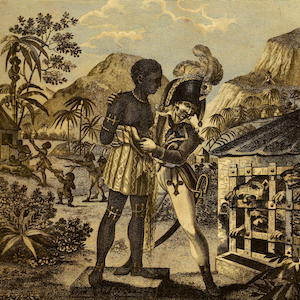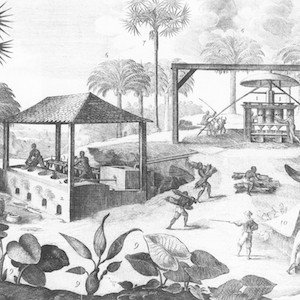Slavery

Toussaint L’Ouverture
A slave inspired by the French Revolution’s egalitarianism, Toussaint saw himself as French and struggled for French control of the island of Saint Domingue. Nonetheless, he had no intention of letting whites rule, for he wanted blacks to control their own destinies.

The Mode of Training Blood Hounds in St. Domingo
This image reveals grotesque mistreatment of blacks even during training exercises. Here a French cavalryman (chasseur) plans to use someone as a live prey for hunting dogs.

The Mode of Exterminating the Black Army as Practised by the French
The fighting between the French and the Haitians was very bloody. When the French tried to put down Toussaint in 1802, it took them some five months with an expeditionary force of 23,000. Supplied by locals, the French seized the towns, gradually extending their control to the countryside.

Revenge Taken by the Black Army for the Cruelties Practised on Them by the French
This execution in Haiti simply suspends the French officer in the air, slowly strangling him to death. His struggles, emphasized by the convulsing legs, reveal the hatred visited on opponents, themselves guilty of so many atrocities.

Enslaved and Free Blacks in Saint Domingue
This engraving pairs images of enslaved people and free blacks in four categories: dress, deportment, entertainment, and access to water. Although there are differences between the pairs, these are not as great as they might be.

The Indigo Plant Farm
This print depicts and labels the essential components of a plantation producing indigo, a blue dye used for coloring cloth. Slaves are shown here working at different parts of the production process. In 1789, over 3,000 plantations in Saint Domingue produced indigo.

The Sugar Mill
This depiction of a sugar plantation in Saint Domingue emphasizes the grinding mill and refining vats. An overseer with a gun supervises the enslaved labor. By 1789 Saint Domingue excelled at sugar production, outpacing other French colonies and the British alike.

The Barnyard
As shown in this print, numerous activities of plantation life were carried out by enslaved people. This scene includes women and children, who formed a relatively small part of the enslaved population.

Incidents in the Life of a Slave Girl
The book-length narrative, Incidents in the Life of a Slave Girl (1861), chronicles the experiences of Harriet Jacobs who was born a slave in Edenton, North Carolina, in 1813.

Excerpts from The Interesting Narrative of the Life of Olaudah Equiano
One of the very first slave narratives, The Interesting Narrative of Olaudah Equiano (1745-1797), served as a prototype for the well-known slave autobiographies of the 19th century written by such fugitive slaves as Frederick Douglass and Harriet Jacobs.